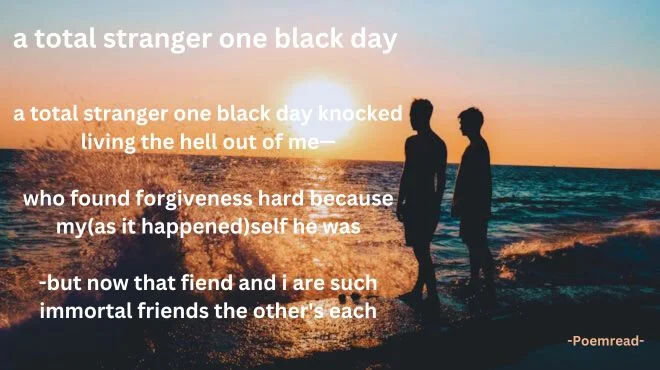
Let’s dive into the captivating world of “A Total Stranger One Black Day” by E.E. Cummings! This poem is like a treasure chest filled with emotions and surprises, inviting us to explore the complexities of forgiveness and redemption. Through Cummings’ unique style, we’ll uncover the power of language and the beauty of human connection.
In this blog post, we will study various literature-related aspects of the poem, including its subject, the author, the context, the theme and tone, and the form or structure. Whether you are a literature student or simply have an interest in poetry, this article aims to provide a complete and well-detailed exploration of the poem that will resonate with ordinary readers. So, grab your literary map, and let’s embark on this unforgettable journey together!
a total stranger one black day a total stranger one black day knocked living the hell out of me— who found forgiveness hard because my(as it happened)self he was -but now that fiend and i are such immortal friends the other's each
Content
- About the Author of "A Total Stranger One Black Day": E.E. Cummings
- Context of "A Total Stranger One Black Day"
- Subject of "A Total Stranger One Black Day"
- Theme and Tone of "A Total Stranger One Black Day"
- Form and Structure of "A Total Stranger One Black Day"
- Rhyme Scheme of "A Total Stranger One Black Day" and Its Significance
- Line-by-Line Analysis of "A Total Stranger One Black Day"
- Exploring Literary and Poetic Devices of "A Total Stranger One Black Day"
- Interactive Summary
About the Author of “A Total Stranger One Black Day”: E.E. Cummings
E.E. Cummings, born Edward Estlin Cummings on October 14, 1894, was a pioneering American poet known for his innovative use of language and form. Cummings, who grew up in Cambridge, Massachusetts, started writing poetry at a young age and drew inspiration from authors like Walt Whitman and Gertrude Stein.
After graduating from Harvard University in 1915, he volunteered for the Norton-Harjes Ambulance Corps during World War I, an experience that deeply influenced his poetry. Cummings’ first collection, “The Enormous Room” (1922), drew from his time as a prisoner of war and showcased his experimentation with form and syntax.
Throughout his career, he continued to challenge poetic conventions, exploring themes of love, nature, and the human experience. Cummings’ work earned him critical acclaim, and he remains celebrated as one of the most innovative poets of the 20th century. He passed away on September 3, 1962, leaving behind a rich legacy of creativity and insight.
Context of “A Total Stranger One Black Day”
Understanding the context in which “A Total Stranger One Black Day” was crafted is essential to grasp its depth and resonance. Cummings, a pivotal figure in modernist poetry, penned this work during a period of significant societal upheaval and personal reflection.
The early 20th century witnessed swift social, political, and cultural transformations, as the repercussions of World War I deeply influenced society. Amidst this backdrop of uncertainty and turmoil, artists and writers like Cummings sought to break free from traditional literary norms, experimenting with language and form to express the complexities of the modern experience.
Cummings, influenced by avant-garde movements such as cubism and surrealism, drew inspiration from unconventional sources to craft his poetry. His innovative use of punctuation, typography, and syntax reflects the spirit of experimentation prevalent in the era.
In “A Total Stranger One Black Day,” Cummings explores themes of forgiveness, reconciliation, and human connection—themes that resonate deeply in a world grappling with the aftermath of war and upheaval. Through his evocative imagery and lyrical prose, Cummings invites readers to confront the challenges of forgiveness. Furthermore, he encourages them to embrace the transformative power of empathy and understanding.
By situating the poem within its broader historical and cultural context, we gain a deeper appreciation for Cummings’ artistic vision and the timeless relevance of his work. “A Total Stranger One Black Day” serves as a powerful reminder of the enduring power of poetry to illuminate the human experience and offer solace in times of uncertainty.
Subject of “A Total Stranger One Black Day”
In “A Total Stranger One Black Day,” Cummings explores a life-altering encounter that has an immense impact on the narrator. The poem centers around the emergence of a “stranger,” which symbolizes an aspect of the narrator’s own personality or psyche.
At its core, the poem grapples with the complexities of self-discovery and introspection. The “stranger” represents a hidden facet of the narrator’s identity, challenging their perception of themselves and their understanding of forgiveness, redemption, and human connection.
Through Cummings’ evocative imagery and lyrical prose, readers are drawn into the emotional journey of the narrator as they navigate the turbulent waters of forgiveness and redemption. Additionally, the poem invites introspection, challenging readers to confront their own preconceptions about forgiveness and self-discovery.
As we unravel the layers of “A Total Stranger One Black Day,” we are reminded of the fragility and resilience of the human spirit. Through its exploration of forgiveness and reconciliation, the poem offers a powerful meditation on the complexities of the human experience and identity. It also highlights the enduring power of self-acceptance and understanding to overcome adversity and foster connection.
Theme and Tone of “A Total Stranger One Black Day”

The themes of self-discovery, forgiveness, and reconciliation permeate “A Total Stranger One Black Day,” echoing the complexities of human emotions. The poem explores the journey towards understanding and accepting one’s own inner demons and hidden aspects of personality.
The tone of the poem evolves from initial shock and disbelief to introspection and acceptance. At the beginning, there’s a sense of turmoil as the narrator encounters the stranger, symbolizing the emergence of a hidden aspect of their own personality. As the poem progresses, the tone shifts towards contemplation and reconciliation, reflecting the narrator’s growing awareness and acceptance of this inner “stranger.”
Through Cummings’ masterful use of language and form, “A Total Stranger One Black Day” delves into the complexities of self-discovery and acceptance. It serves as a reminder of the universal human experience of grappling with inner demons and the transformative power of self-acceptance and forgiveness.
Form and Structure of “A Total Stranger One Black Day”
In “A Total Stranger One Black Day” by E.E. Cummings, the form and structure of the poem play a crucial role in conveying its message and emotions. Let’s explore how Cummings’ choices in form and structure enhance the reader’s experience.
In “A Total Stranger One Black Day” by E.E. Cummings, the poem is structured as three couplets, each consisting of two lines. This arrangement creates a sense of balance and symmetry within the poem. The use of couplets also allows for a rhythmic flow, with each pair of lines forming a cohesive unit.
Cummings’ choice of couplets emphasizes the interconnectedness of the poem’s themes and ideas. Each couplet builds upon the previous one, creating a sense of progression and development throughout the poem. Additionally, the use of couplets provides a natural pause between each pair of lines, allowing readers to reflect on the meaning and emotions conveyed.
Cummings’ innovative use of punctuation and syntax adds another layer of complexity to the poem’s structure. He often eschews traditional punctuation rules, opting instead for unconventional spacing and line breaks. This stylistic choice serves to heighten the poem’s sense of rhythm and flow while also inviting readers to interpret the text in their own way.
Additionally, Cummings’ use of enjambment—continuing a sentence or phrase onto the next line—creates a sense of fluidity and movement within the poem. This technique allows for a seamless transition between lines, enhancing the poem’s overall cohesion and impact.
The absence of traditional punctuation marks also contributes to the poem’s ambiguity and open-endedness. By leaving out periods and commas, Cummings encourages readers to pause and ponder the meaning of each line, inviting multiple interpretations and engaging the reader in a deeper exploration of the text.
Overall, the form and structure of “A Total Stranger One Black Day” serve to enhance the poem’s emotional resonance and thematic depth. Through Cummings’ innovative use of rhythm, punctuation, and syntax, the poem becomes not just a piece of writing but a rich masterpiece of meaning and emotion waiting to be unraveled by the reader.
Rhyme Scheme of “A Total Stranger One Black Day” and Its Significance
In “A Total Stranger One Black Day” by E.E. Cummings, the rhyme scheme is non-traditional and sporadic, yet it serves to enhance the poem’s musicality and emotional impact. Unlike traditional poems with consistent rhyme patterns, Cummings’ poem utilizes internal rhyme and assonance to create a subtle, yet resonant, sense of harmony within the text. Rather than adhering to a strict rhyme scheme, Cummings allows the rhymes to emerge naturally within the flow of the poem, lending it a sense of spontaneity and fluidity.
The sporadic use of rhyme underscores the unpredictability and complexity of human emotions, mirroring the nuanced journey of forgiveness and reconciliation explored in the poem. By weaving rhymes throughout the text, Cummings adds depth and texture to the poem, enriching the reader’s experience and drawing attention to key moments of emotional resonance.
Furthermore, the absence of a consistent rhyme scheme reflects Cummings’ avant-garde approach to poetry, challenging traditional notions of structure and form. This unconventional use of rhyme serves to emphasize the poem’s themes of unpredictability and ambiguity, inviting readers to embrace the uncertainty of life and relationships.
Overall, while “A Total Stranger One Black Day” may not adhere to traditional rhyme conventions, Cummings’ skillful use of internal rhyme and assonance adds a layer of musicality and depth to the poem, enhancing its emotional resonance and inviting readers to immerse themselves in its rich, poetic landscape.
Line-by-Line Analysis of “A Total Stranger One Black Day”
a total stranger one black day
This line introduces the central metaphor of the poem, presenting the “stranger” as a sudden and unexpected intrusion into the narrator’s life. The phrase “one black day” suggests a moment of darkness or despair, emphasizing the emotional impact of the encounter.
knocked living the hell out of me—
Here, the narrator vividly describes the profound effect of the encounter with the “stranger,” using hyperbolic language to convey the intensity of the experience. The phrase “knocked living the hell out of me” suggests that the encounter has disrupted the narrator’s sense of self and emotional equilibrium. The dash at the end of the line adds emphasis and creates a pause, allowing the reader to reflect on the narrator’s state of mind.
who found forgiveness hard because
This line reflects the narrator’s initial struggle to come to terms with the “stranger” or accept this unfamiliar aspect of themselves. The phrase “found forgiveness hard” suggests internal conflict and resistance as the narrator grapples with feelings of guilt or shame associated with this hidden aspect of their personality.
my(as it happened)self he was
Here, the parentheses around “as it happened” indicate a moment of realization or acknowledgment on the part of the narrator. The line suggests that the “stranger” is not an external individual but rather an aspect of the narrator’s own identity or psyche.
The use of “myself” reinforces this interpretation, highlighting the intimate connection between the narrator and the “stranger.” The use of enjambment creates a sense of continuity between this line and the next, propelling the narrative forward.
-but now that fiend and i are such
In this line, the dash indicates a shift in perspective or attitude on the part of the narrator. The use of “fiend” to describe the “stranger” suggests a negative or challenging aspect of the self that the narrator has now come to terms with or accepted. The phrase “are such” emphasizes the mutual recognition and acceptance between the narrator and this hidden aspect of their personality.
immortal friends the other’s each
The final line of the poem encapsulates the narrator’s reconciliation with this aspect of themselves, acknowledging that they are interconnected and inseparable. The phrase “immortal friends” suggests a lasting and unbreakable bond between the narrator and the “stranger,” symbolizing the acceptance and integration of this hidden aspect of their personality into their sense of self.
Through its evocative imagery and emotional depth, “A Total Stranger One Black Day” invites readers to reflect on the complexities of forgiveness and reconciliation, leaving them with a sense of hope and renewal.

What is the meaning of “A Total Stranger One Black Day”?
The essence of “A Total Stranger One Black Day” by E.E. Cummings revolves around the narrator’s internal journey and the exploration of their own psyche. The “stranger” in the poem symbolizes an aspect of the narrator’s own personality or identity rather than a separate individual.
Throughout the poem, the narrator grapples with coming to terms with this “stranger” within themselves. Initially, there is a struggle to accept and forgive this hidden aspect of their own being, which disrupts their sense of self.
However, as the poem progresses, the narrator undergoes a transformation. They begin to embrace and reconcile with this “stranger” within, ultimately finding understanding and empathy towards themselves. This journey of self-discovery highlights the transformative power of acceptance and forgiveness, not only towards others but also towards oneself.
In essence, “A Total Stranger One Black Day” conveys a message of self-acceptance, introspection, and the journey towards reconciliation with one’s own inner demons.
Exploring Literary and Poetic Devices of “A Total Stranger One Black Day”
In “A Total Stranger One Black Day” by E.E. Cummings, the poet employs a variety of literary and poetic devices to convey his message and evoke emotions. Let’s delve into some of these devices and how they enhance the poem:
1. Imagery
Cummings uses vivid imagery to paint a picture in the reader’s mind. Phrases like “knocked living the hell out of me” evoke a strong visual and emotional response, helping readers connect with the narrator’s experience.
2. Personification
The poet personifies forgiveness, giving it human qualities and attributes. This technique helps to emphasize the struggle and complexity of the narrator’s journey towards forgiveness.
3. Enjambment
Cummings utilizes enjambment to create a sense of flow and continuity between lines. By carrying a sentence or phrase over to the next line, he maintains the poem’s momentum and rhythm, drawing readers deeper into the narrative.
4. Unconventional Punctuation
Throughout the poem, Cummings employs unconventional punctuation, such as dashes and parentheses, to add emphasis and create pauses. This unconventional use of punctuation adds to the poem’s unique rhythm and tone.
5. Assonance and Consonance
The poet incorporates assonance (repetition of vowel sounds) and consonance (repetition of consonant sounds) to create musicality and enhance the poem’s auditory appeal. This technique adds texture to the language and enriches the overall reading experience.
6. Symbolism
Certain elements in the poem, such as the “total stranger” and the color “black,” may carry symbolic meaning. The stranger could represent unexpected challenges or opportunities for growth, while the color black may symbolize darkness or turmoil.
7. Irony
The poem contains elements of irony, particularly in the narrator’s initial struggle to forgive the stranger, who ultimately becomes a close friend. This irony adds depth to the poem’s exploration of forgiveness and redemption.
8. Repetition
Cummings employs repetition of phrases, such as “a total stranger” and “immortal friends,” to reinforce key themes and ideas. This repetition creates a sense of unity and cohesion throughout the poem.
9. Ambiguity
The poet leaves certain aspects of the poem open to interpretation, inviting readers to engage with the text on a deeper level. This ambiguity allows for multiple readings and adds layers of complexity to the poem.
Through the skillful use of these literary and poetic devices, Cummings crafts a rich and evocative poem that resonates with readers on multiple levels. Each device serves to enhance the poem’s emotional impact and contribute to its enduring significance in the world of literature.
Interactive Summary
In “A Total Stranger One Black Day,” E.E. Cummings evokes a range of emotions, from initial shock and resentment to eventual acceptance and reconciliation. The tone of the poem conveys a sense of introspection and vulnerability as the narrator grapples with the complexities of forgiveness.
Cummings’ intention is to challenge readers to confront their own preconceptions about forgiveness and human connection, inviting them to consider the transformative power of self-discovery and understanding. The stranger within the poem symbolizes an aspect of the narrator’s own personality, prompting readers to reflect on their own internal conflicts and journeys towards self-acceptance.
Targeted at individuals who have grappled with the complexities of forgiveness and reconciliation, “A Total Stranger One Black Day” offers a powerful reminder of the transformative power of forgiveness, empathy, and understanding, both towards others and oneself.
If you enjoyed exploring themes of self-identity and acceptance in “A Total Stranger One Black Day,” you may also appreciate Sylvia Plath’s “Mirror,” which explores similar introspective themes of self-perception and acceptance.
RELATED POSTS
View all



